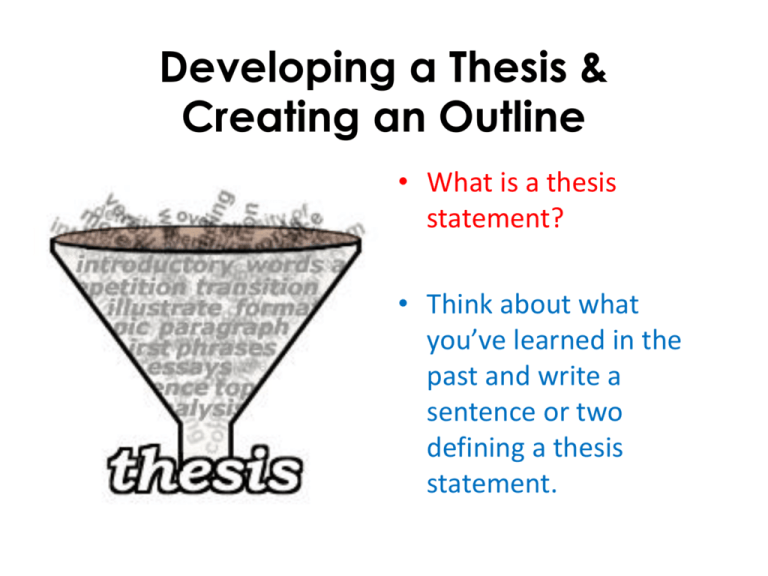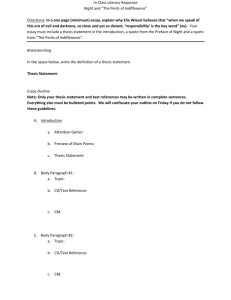
Developing a Thesis &
Creating an Outline
• What is a thesis
statement?
• Think about what
you’ve learned in the
past and write a
sentence or two
defining a thesis
statement.
Defining a Thesis Statement
• “A Thesis Statement is the main point of an essay.
• It explains what the essay will be about and
expresses the writer’s position on the subject.
• It may also give clues about how the essay will
develop or how it will be organized.”
-Kathleen T. McWhorter
Here’s an example:
Euthanasia laws should be legalized worldwide because
terminally ill people are suffering in pain; additionally, they
should have the choice to decide how to die, and research
shows most people support it.
Drafting the Thesis Statement
• Often, the writer does not
immediately develop an effective
thesis statement.
• She will write several versions of
the thesis before she finds one
that seems to be correct.
• The thesis may change as the
writer drafts the paper, finds new
research, and adjusts the
organization of the paper.
• Until the paper is finished, it may
be called a “working thesis.”
• It should have a “road map” that
previews the organization.
Writing an Effective Thesis Statement
• Make a claim (point of
view on an issue). This
claim should be
debatable.
• Be specific and focus on
one central point.
• Offer an original
perspective on the topic.
• Avoid making an
announcement (In this
paper, I will…).
• Use it to preview the
organization (road map)
of the essay.
Practice: What’s wrong with each
thesis statement below?
1. In this paper, I will discuss
the causes of asthma,
which include exposure to
smoke, chemicals, and
allergic reactions.
2. On the Food Network
television show Chopped,
chefs compete for money
and recognition.
3. Living in an apartment has
many advantages.
4. Children’s toys can be
dangerous, instructional,
or creative.
Writing an Effective Thesis Statement
Answers
Practice: What’s wrong with each thesis statement below?
1. In this paper, I will discuss the causes of asthma, which
include exposure to smoke, chemicals, and allergic
reactions. This makes an announcement and uses first
person point of view.
2. On the Food Network television show Chopped, chefs
compete for money and recognition. This does not have
a claim. It’s simply a fact of information so there is
nothing to debate.
3. Living in an apartment has many advantages. This is
vague and not specific enough.
4. Children’s toys can be dangerous, instructional, or
creative. This does not focus on one point and the ideas
may contradict one another.
More on the Thesis Statement
•The thesis
usually goes in
the first
paragraph.
•Sometimes it
can be found in
the last
paragraph.
•It must be
supported with
logical evidence.
Like the Greek God Atlas, the writer
must support his thesis with logical
evidence.
Types of Evidence
• Factual or descriptive
details
• Anecdotes
• Examples
• Statistics
• Quotations from
experts
• Scientific studies
• Definitions
• Historical background
• Don’t use all types of
evidence in one essay.
• Make sure the evidence is
relevant to the topic.
• Provide specific evidence.
• Give sufficient evidence.
• Make sure the evidence is
not unusual or rare.
• Check for accuracy.
• Keep it objective.
Not All Evidence is Equal
Claim: Students should not be required to take the SAT
for college admission. Which evidence would be
effective? Why?
1. Some colleges don’t require the SAT.
2. Some students have test anxiety so they perform
poorly.
3. Grade point averages reflect student abilities better
than SAT scores.
4. A person’s testing ability doesn’t correlate with success
in the real world.
5. Data shows that the SAT is unfair to students with less
family income (poorer students).
Not All Evidence is Equal- Possible Answers
1.
2.
3.
4.
5.
Not the best evidence. This is true for about 700 schools (although they
may require different placement tests), but at least 4,000 colleges
require SAT scores for admission.
Not the best evidence. College courses often require tests as part of the
course grade (in fact, some courses may rely on 2-3 exams), so students
need strategies to cope with test anxiety.
Not the best evidence. The rigor at different high schools may vary.
Thus, a student who gets a 4.0 grade point average at high school ‘A’ may
have learned significantly more than a student who earned a 4.0 at high
school ‘B’.
Not the best evidence. In fact, according to a study in the scholarly
journal, Current Directions in Psychological Science, data shows a strong
correlation between success on the SAT and success in both college and
work.
Strongest evidence. Even the College Board (the company in charge of
the SAT) provides data that shows that lower income students have a
disadvantage. In fact, the SAT is changing its format in 2016 to decrease
this disadvantage.
The Outline
• A general plan of the
material that is to be
presented in a speech or
a paper
• It shows the order of the
various topics, the
relative importance of
each, and the relationship
between the various parts
• Subdivide topics by a
system of numbers and
letters (or bullets)
Zooming in on a Section of an Outline
II. Support 1 to justify your argument : Research shows
diseases are caused from second-hand smoke
•Evidence: Upper Respiratory Problems (Article 3)
Asthma
Bronchitis
Ear Infections
•Evidence: Cardiovascular Problems (Article 3)
Heart disease
High blood pressure
•Evidence: Cancer (Article 3)
Toxins in cigarettes (arsenic, formaldehyde) cause cancer
Lung cancer, breast cancer, leukemia
Each Roman
numeral
starts a new
topic and
could
become a
topic
sentence.
The bullets
indicate
details to
support the
topic.
Formal
outlines use
capital
letters.
Writing the Essay
• Once the outline is filled out, the essay is quite easy to
write.
• Your ideas are organized. It is important to have good
transition words between each main paragraph, such
as first, additionally, for instance, furthermore, hence,
etc.
• The five paragraph essay includes an introduction,
three body paragraphs and a conclusion. Some
instructors will require a “however” paragraph with
counterargument and refutation.
Thank you for purchasing this product! I hope you find this
activity beneficial to your instruction and students’ learning.
Please consider following me. As a follower, you will be the first
to receive information about new products and updates.
Copyright © 2014 Kimberly Patrick
http://www.teacherspayteachers.com/Store/Ocbeachteacher
All rights reserved by author.
Permission for single classroom use only.
Electronic distribution limited to single
classroom use only.
Credits:
•
Light bulb clip art from http://www.teacherspayteachers.com/Store/Hardcore-TeacherResources
•
Thesis image fromhttp://hcms-renaissance-research./Writing+a+Thesis+Statement
•
Image of Atlas By Gustavo Trapp (Self taken photo.) [Public domain], via Wikimedia
Commons
OC Beach Teacher Facebook
OC Beach Teacher Pinterest
Cross Curricular Corner Blog




